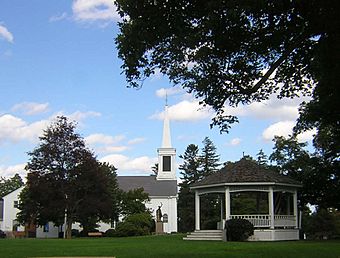Milton Centre Historic District facts for kids
Quick facts for kids |
|
|
Milton Centre Historic District
|
|
 |
|
| Location | Canton Ave. between Readsdale Rd. and Thacher and Highland Sts., Milton, Massachusetts |
|---|---|
| Area | 23 acres (9.3 ha) |
| Built | 1907 |
| Architect | Shepley, Rutan & Coolidge; Et al. |
| Architectural style | Late 19th And 20th Century Revivals, Late Victorian, Federal |
| NRHP reference No. | 88000428 |
| Added to NRHP | April 28, 1988 |
The Milton Centre Historic District is a special area in Milton, Massachusetts. It holds many important old buildings that show the town's history. This district is found on Canton Avenue, between Readsdale Road and Thacher and Highland Streets. It includes town buildings, churches, and homes. Most of these buildings were built in the 1700s or 1800s. In 1988, this district was added to the National Register of Historic Places. This means it's recognized as a very important historical site in the United States.
Milton Centre: A Look at Its History
Milton Centre is located on a small hill known as Academy Hill. The town of Milton was first settled in 1633. Back then, it was part of a larger area called Dorchester. Milton became its own separate town in 1662.
The first community building, called a meetinghouse, was built on Milton Hill. But after many discussions, Academy Hill was chosen in 1727 for the town's third meetinghouse. The fourth meetinghouse was built in 1788. Today, this building is known as the First Parish Church. It is the oldest building still standing in the town center.
For a long time, the town's main business and trade happened along the Neponset River. The town center stayed mostly like a countryside area until the 1800s. That's when Milton Academy, a well-known school, was started. It was built on land just east of the town center. After that, the First Congregational Church was built in 1834. A new town hall followed in 1837. The current town hall, built in 1970, stands on the same spot as that old town hall.
Important Buildings and Landmarks
The historic district covers about 23 acres of land. It is divided by Canton Avenue, between Readsdale Road and Thacher and Highland Streets. This area has eleven buildings that are very important to history.
The town's public buildings in the district include the town library. There are also two of Milton's oldest fire stations. One of these is a rare example of an early chemical fire engine house. It shows how firefighters used to put out fires.
You can also find an old "powder house" from 1811 in the district. This building was used to store gunpowder and other supplies during the War of 1812. There are also monuments in the district. These monuments honor the people from Milton who helped the country during the American Civil War and World War I.



